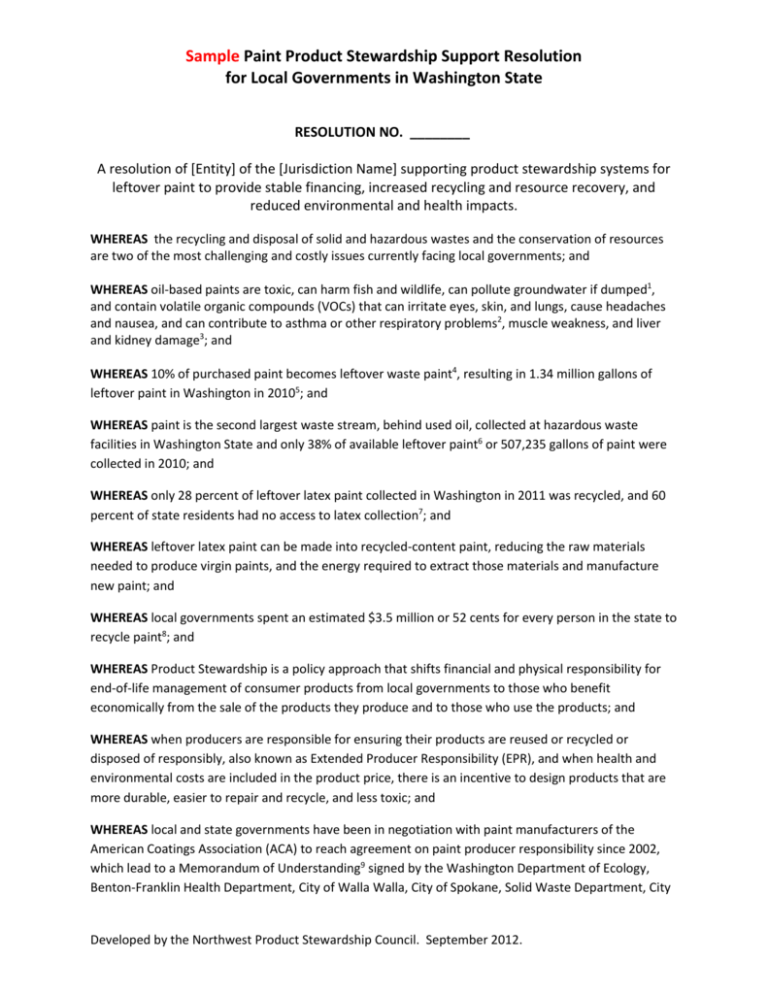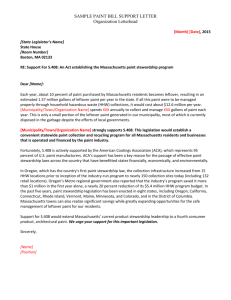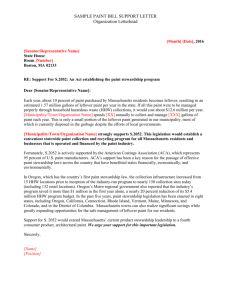Sample Paint Product Stewardship Support Resolution for Local
advertisement

Sample Paint Product Stewardship Support Resolution for Local Governments in Washington State RESOLUTION NO. ________ A resolution of [Entity] of the [Jurisdiction Name] supporting product stewardship systems for leftover paint to provide stable financing, increased recycling and resource recovery, and reduced environmental and health impacts. WHEREAS the recycling and disposal of solid and hazardous wastes and the conservation of resources are two of the most challenging and costly issues currently facing local governments; and WHEREAS oil-based paints are toxic, can harm fish and wildlife, can pollute groundwater if dumped1, and contain volatile organic compounds (VOCs) that can irritate eyes, skin, and lungs, cause headaches and nausea, and can contribute to asthma or other respiratory problems2, muscle weakness, and liver and kidney damage3; and WHEREAS 10% of purchased paint becomes leftover waste paint4, resulting in 1.34 million gallons of leftover paint in Washington in 20105; and WHEREAS paint is the second largest waste stream, behind used oil, collected at hazardous waste facilities in Washington State and only 38% of available leftover paint6 or 507,235 gallons of paint were collected in 2010; and WHEREAS only 28 percent of leftover latex paint collected in Washington in 2011 was recycled, and 60 percent of state residents had no access to latex collection7; and WHEREAS leftover latex paint can be made into recycled-content paint, reducing the raw materials needed to produce virgin paints, and the energy required to extract those materials and manufacture new paint; and WHEREAS local governments spent an estimated $3.5 million or 52 cents for every person in the state to recycle paint8; and WHEREAS Product Stewardship is a policy approach that shifts financial and physical responsibility for end-of-life management of consumer products from local governments to those who benefit economically from the sale of the products they produce and to those who use the products; and WHEREAS when producers are responsible for ensuring their products are reused or recycled or disposed of responsibly, also known as Extended Producer Responsibility (EPR), and when health and environmental costs are included in the product price, there is an incentive to design products that are more durable, easier to repair and recycle, and less toxic; and WHEREAS local and state governments have been in negotiation with paint manufacturers of the American Coatings Association (ACA) to reach agreement on paint producer responsibility since 2002, which lead to a Memorandum of Understanding9 signed by the Washington Department of Ecology, Benton-Franklin Health Department, City of Walla Walla, City of Spokane, Solid Waste Department, City Developed by the Northwest Product Stewardship Council. September 2012. Sample Paint Product Stewardship Support Resolution for Local Governments in Washington State of Vancouver, Solid Waste Division, Clark County, Cowlitz County Public Works, Grays Harbor County, King County Solid Waste Division, Kitsap County Solid Waste Division, Lincoln County Public Works, Pend Oreille County, Snohomish County Solid Waste Division, The Local Hazardous Waste Management Program in King County, Whatcom County Executive, Whitman County Solid Waste Department, Yakima County Solid Waste; and WHEREAS the American Coatings Association, representing both companies and professionals working in the paint and coatings industry, support stewardship legislation requiring the paint manufacturers to finance and manage a paint stewardship program to recycle unwanted architectural paint and industry supported legislation has been enacted in Oregon, California, Connecticut, and Rhode Island; and WHEREAS the American Coatings Association supports legislation in Washington so that similar a product stewardship system for paint can be implemented in Washington state; and WHEREAS it is beneficial to local government, our citizens and our state to support industry-driven initiatives that provide increased recycling and resource recovery, stable financing, and reduced environmental and health impacts; NOW THEREFORE BE IT RESOLVED that [Jurisdiction Name] supports policies and legislation that establish a convenient, safe, and environmentally sound paint stewardship program in Washington State that is financed by the paint manufacturers and covers the cost of collection, transportation, and recycling, and does not rely on state and local government funding. BE IT FURTHER RESOLVED that the [Entity] of [Jurisdiction] be authorized to send letters to the State Legislature and State associations, and to use other advocacy methods to urge support for paint product stewardship legislation. PASSED AND ADOPTED by the [Entity] of [Jurisdiction], State of _______ on _____________________________ by the following vote: Developed by the Northwest Product Stewardship Council. September 2012. Sample Paint Product Stewardship Support Resolution for Local Governments in Washington State 1 2 3 4 5 6 7 8 9 U.S. EPA, “Paintings & Coatings At A Glance: 1996-2005,” 2008 Sector Performance Report. 2008. http://www.epa.gov/sectors/pdf/2008/paint_coatings.pdf. K. Rumchev et al., “Association of domestic exposure to volatile organic compounds with asthma in young children,” Thorax 59 (2004): 746-751. Medline. U.S. National Library of Medicine, National Institutes of Health. http://www.nlm.nih.gov/medlineplus/ency/article/002730.htm (accessed September 25, 2012). Abt Associates Inc., Quantifying the Disposal of Post-Consumer Architectural Paint. Prepared for the U.S. EPA, 2007. Available at http://www.epa.gov/sectors/pdf/paint_quantity_report.pdf. Cascadia Consulting Group, Leftover Paint Management in Washington: A Comparative Analysis of Performance, Costs, and Economic Impacts of the Existing System and a Model Product Stewardship System. Prepared for the Northwest Product Stewardship Council, October 2012. Ibid. Ibid. Ibid. Product Stewardship Institute, Second Paint Memorandum of Understanding. October, 2007. http://productstewardship.us/displaycommon.cfm?an=1&subarticlenbr=118. Developed by the Northwest Product Stewardship Council. September 2012.






